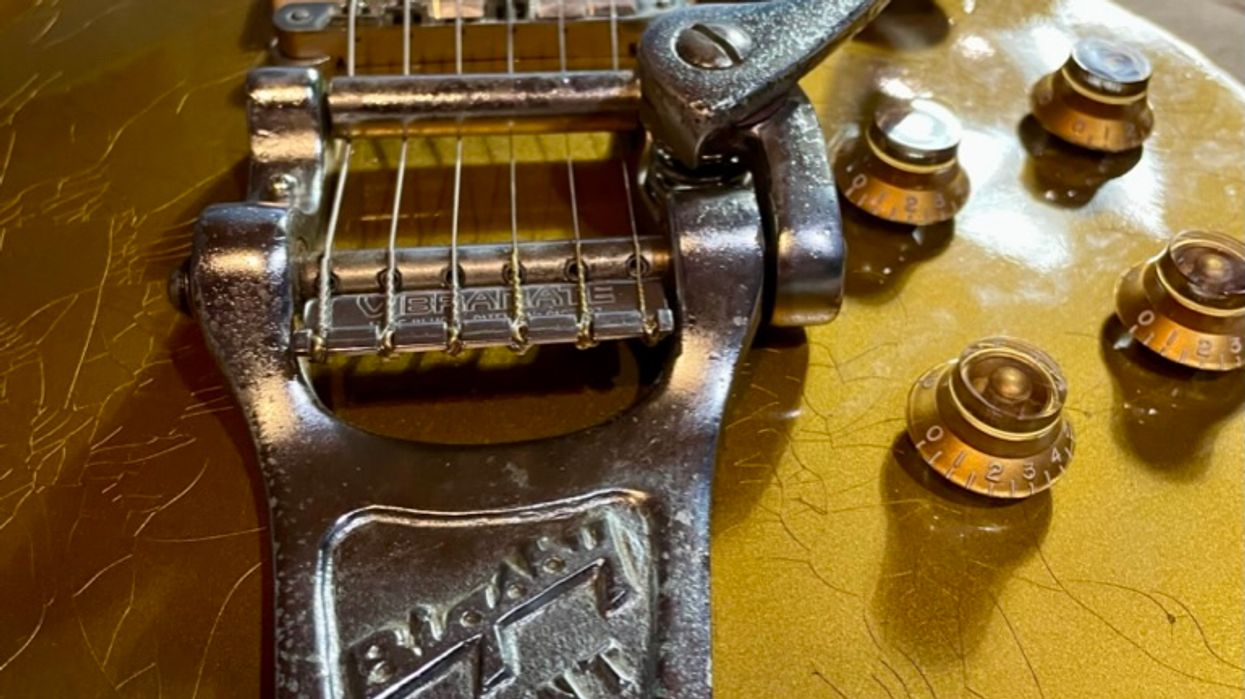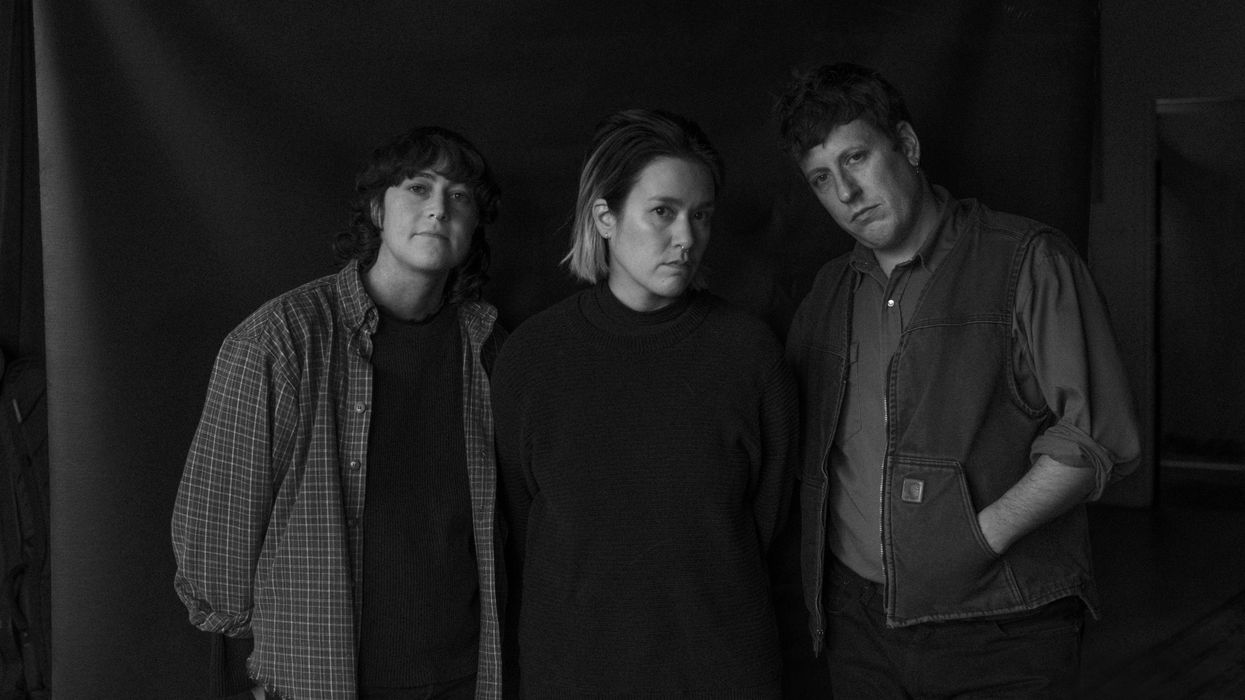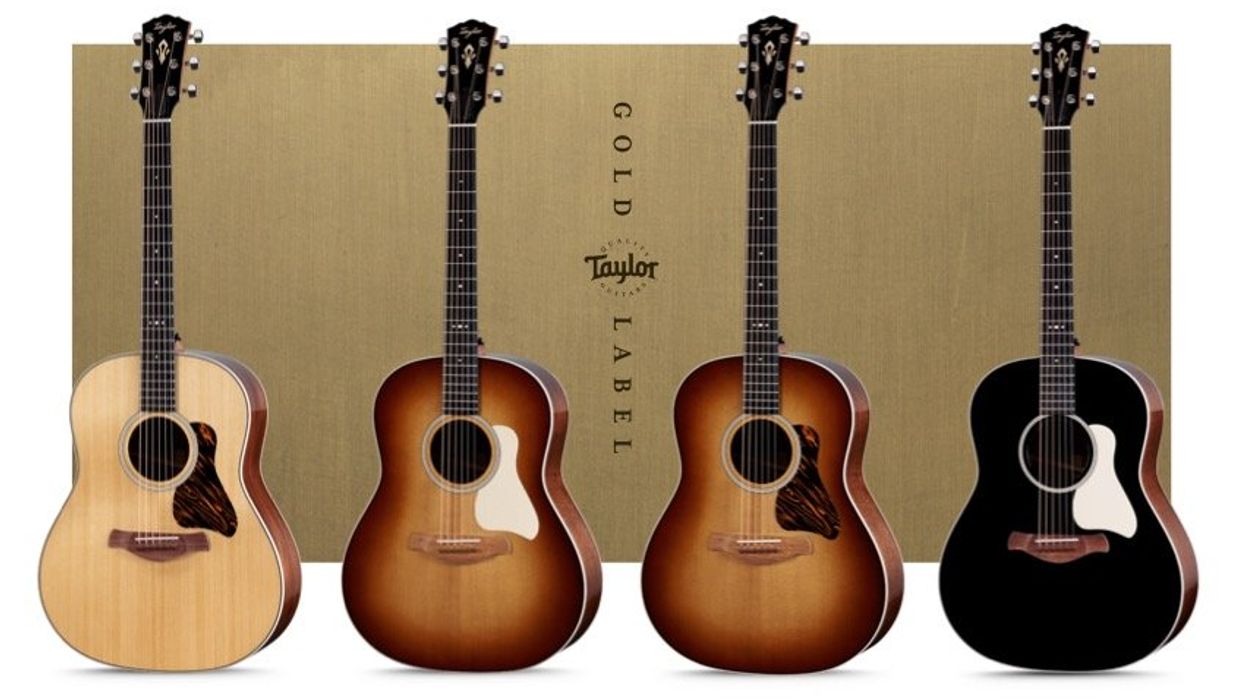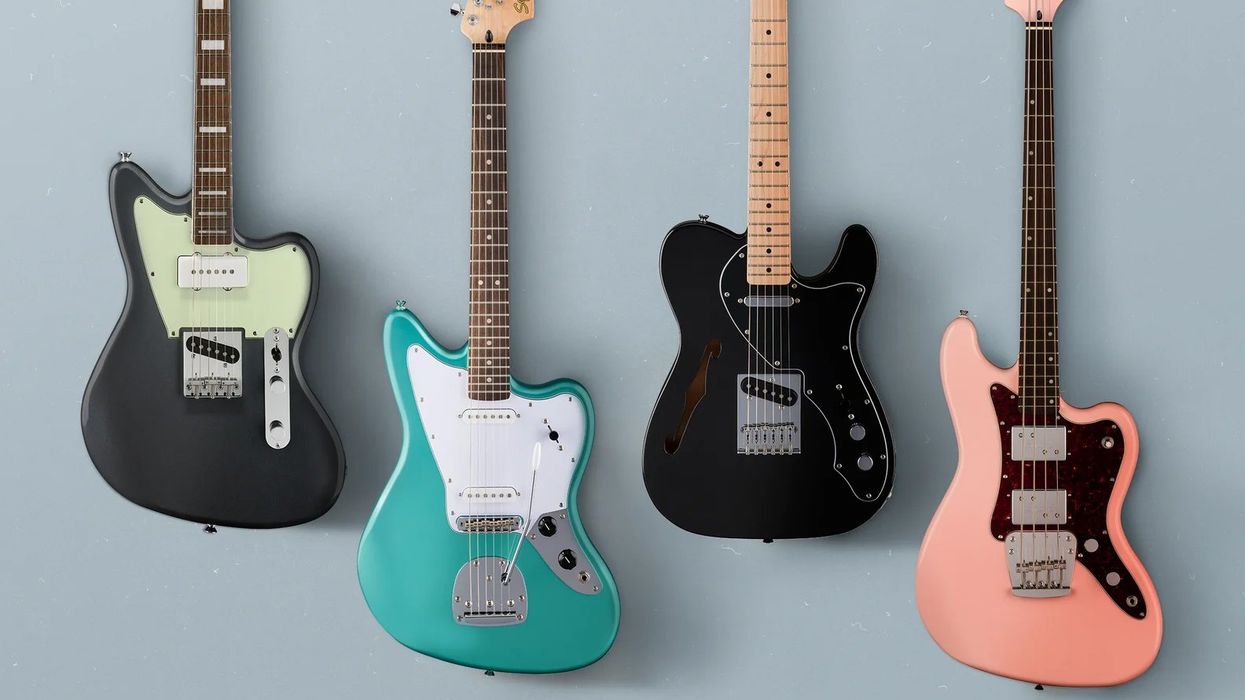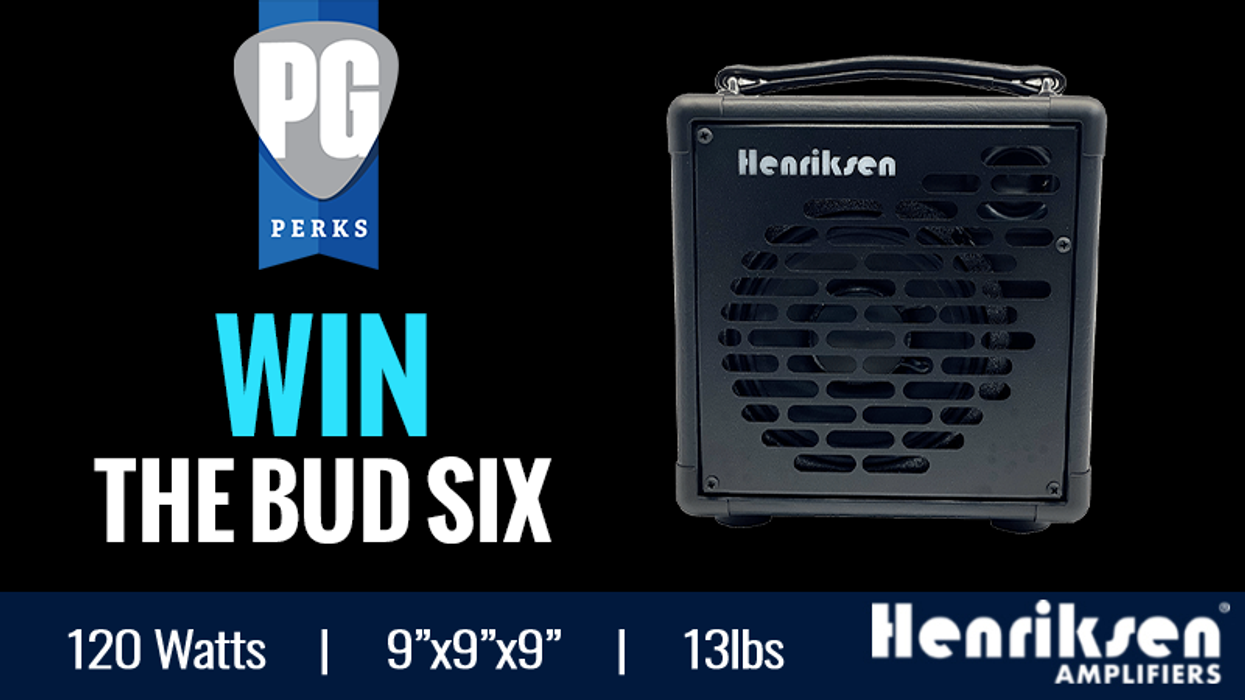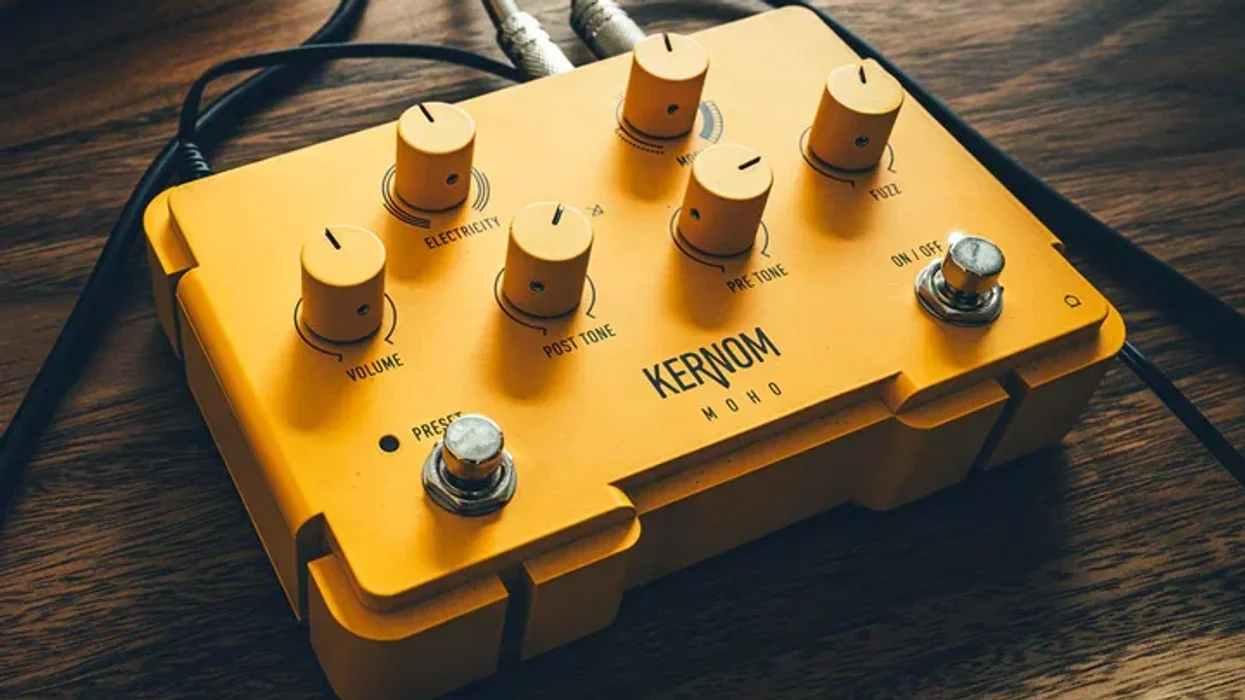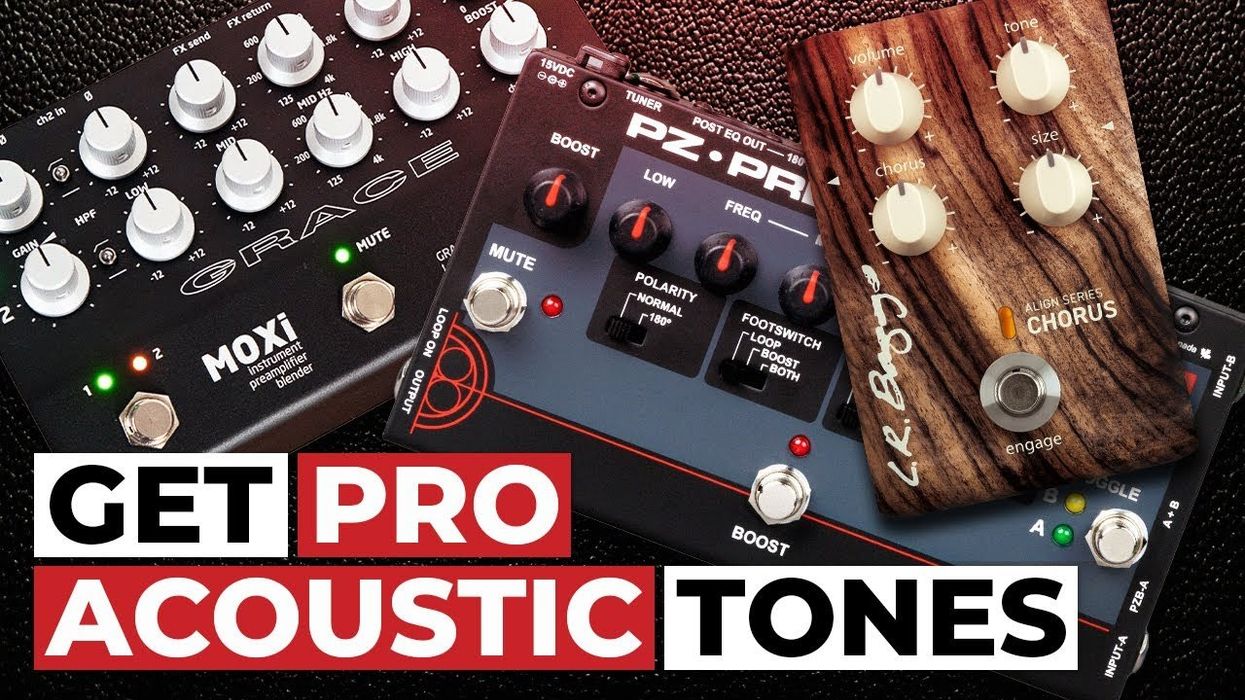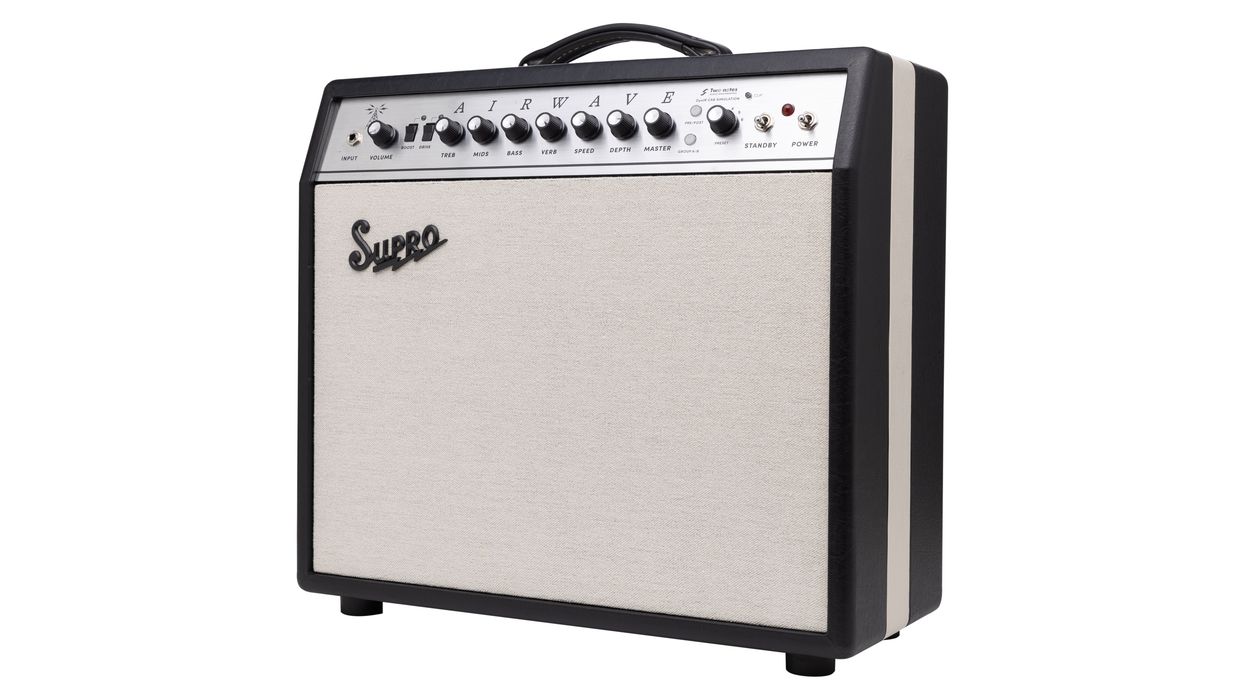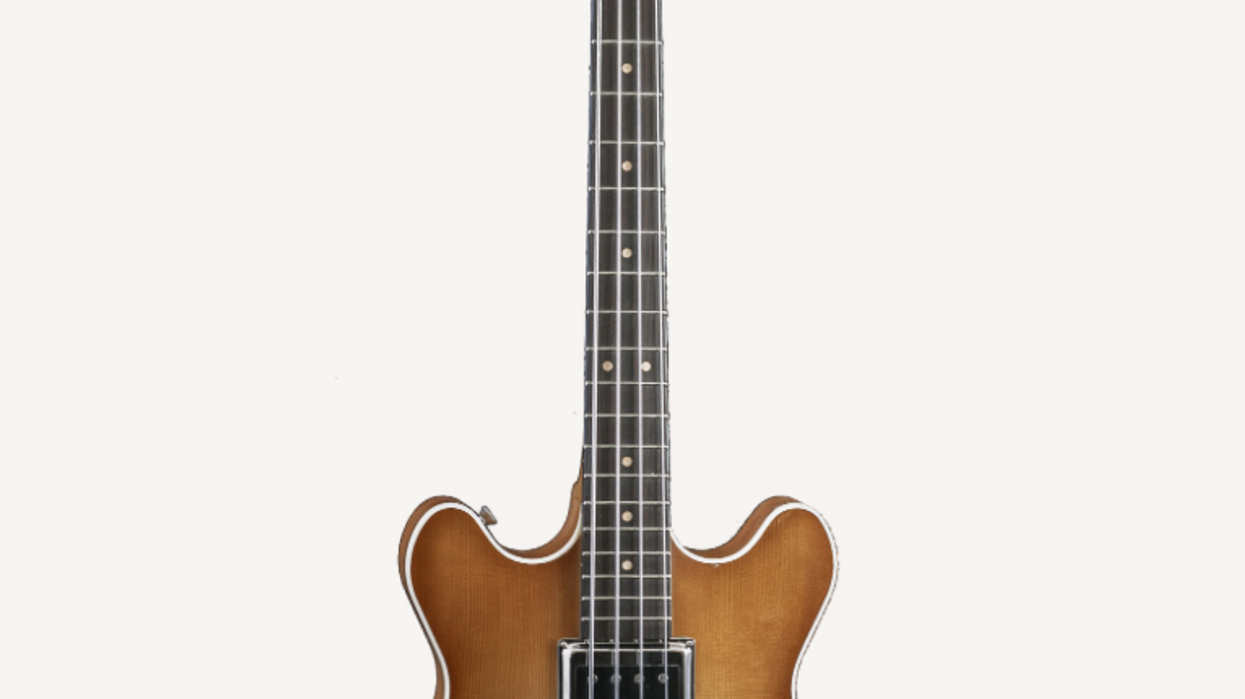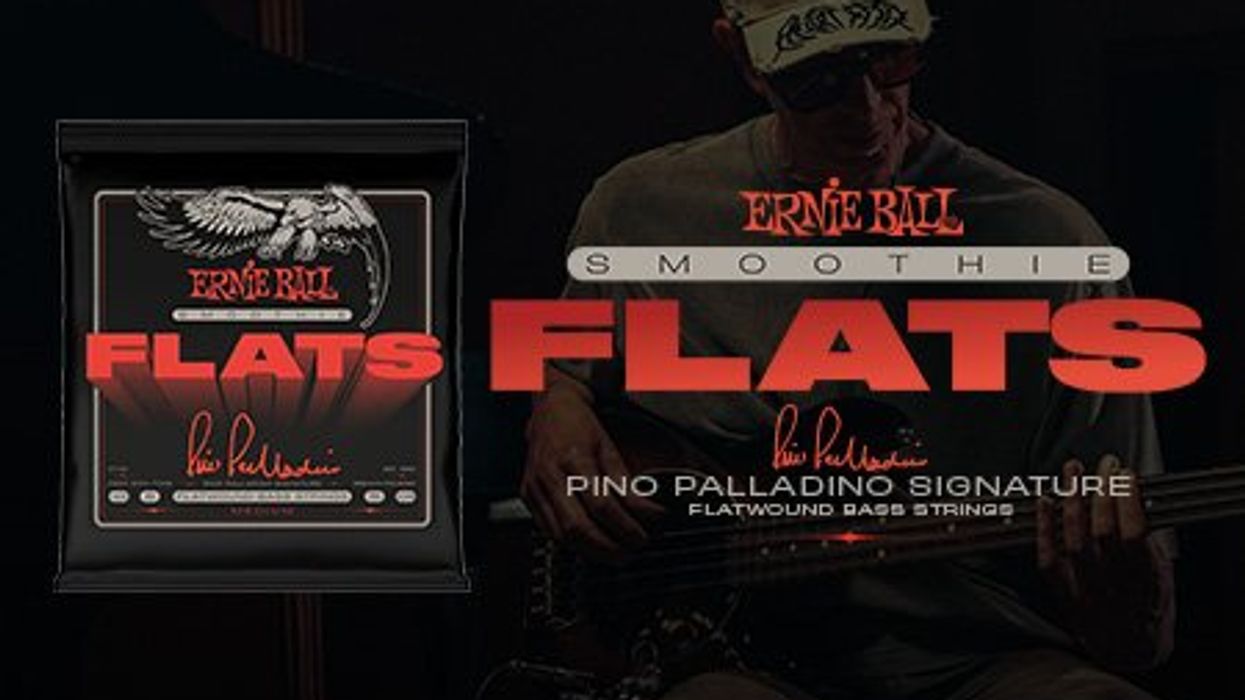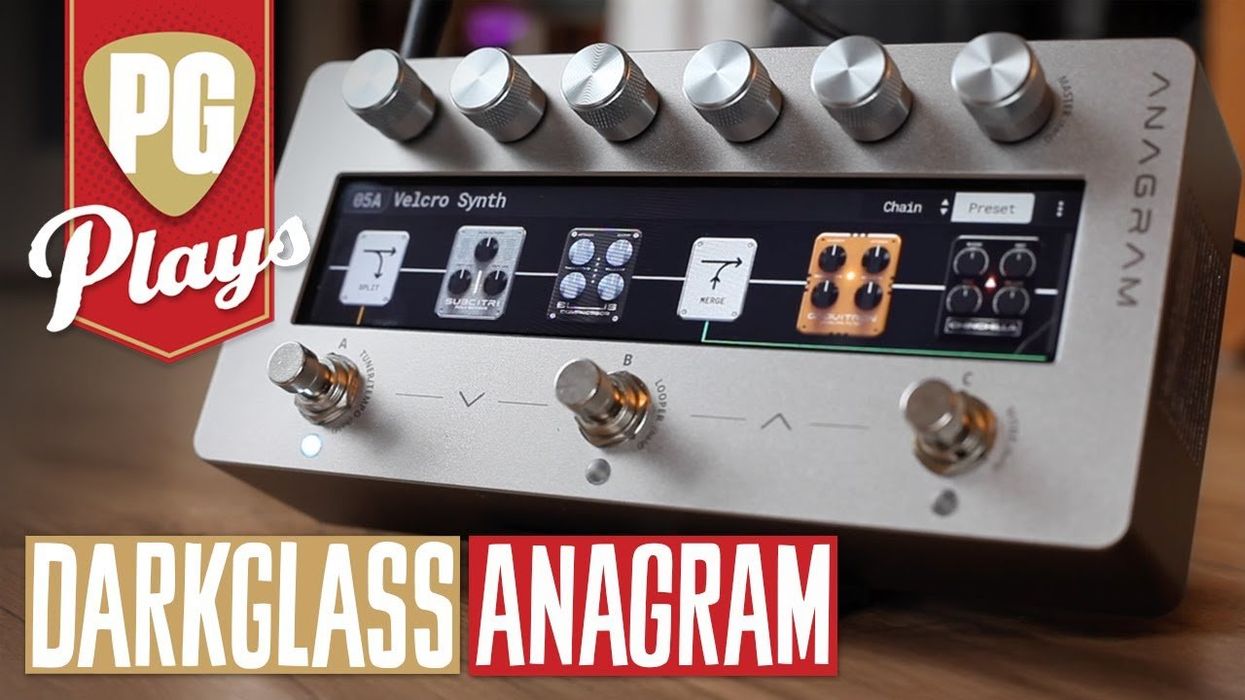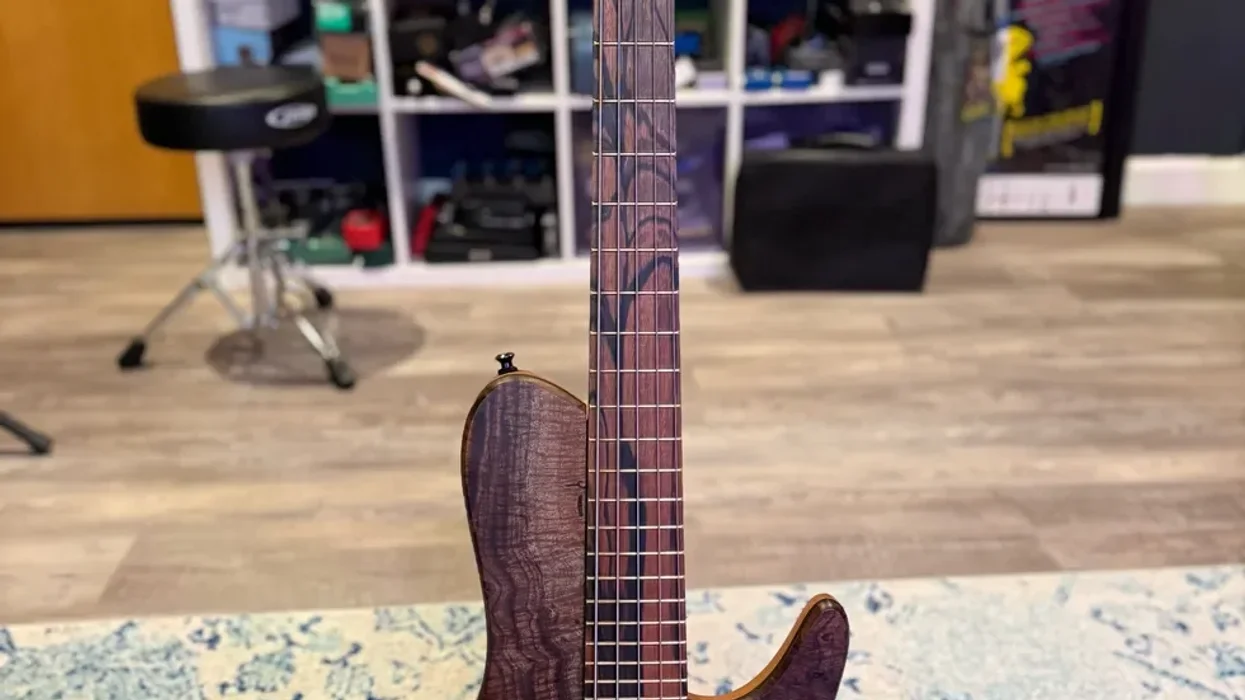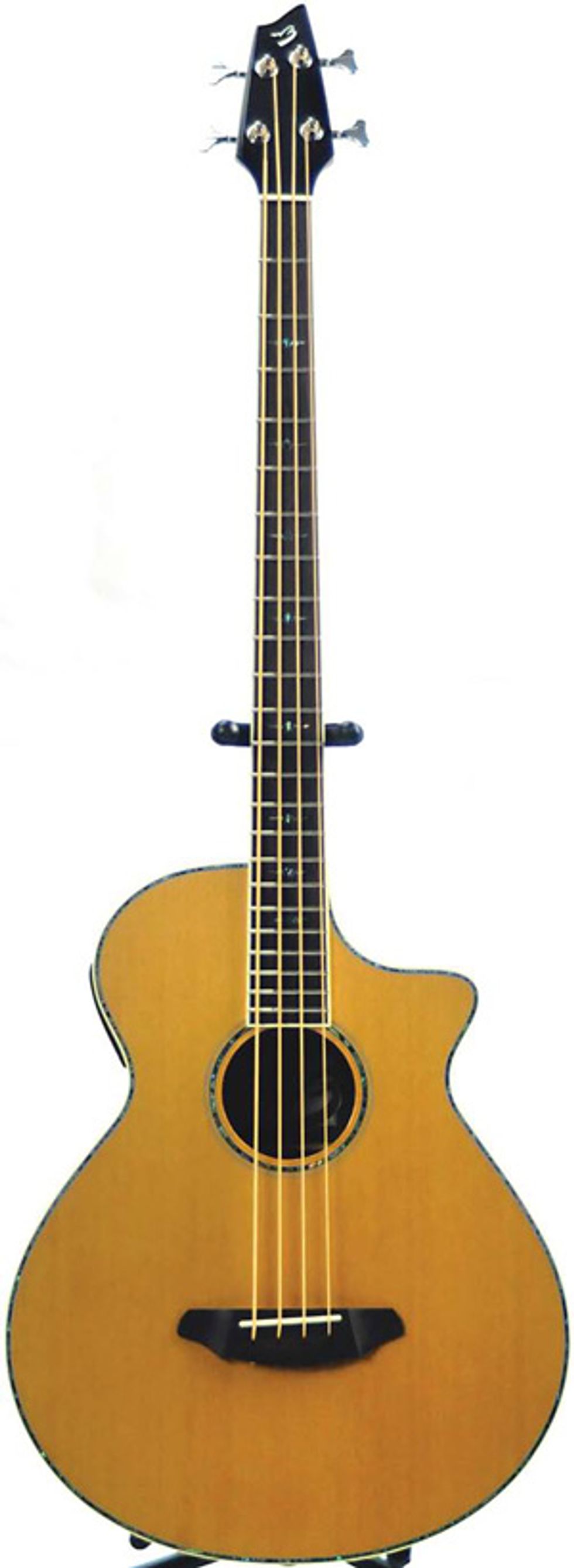 | |
| Download Example 1 Fingerstyle - Pickup then Mic'ed | |
| Download Example 2 Fingerpickin - Pickup then Mic'ed | |
| Pickups recorded with the bass into an AxePort Pro into Garage Band, flat EQ. Mic'ed clips were recorded with the bass into a Studio Projects B-1 Condenser mic six inches from bass at the end of the fingerboard, pointed toward soundhole, into Blue Icicle into GarageBand. | |
The Breedlove BJ350/CR4 is a classy interpretation of the ABG, with a full 34" neck and a body that’s nearly 17" wide at the lower bout—that’s about an inch wider than my old dreadnought acoustic guitar, and about the same depth.
First Impressions
Latches! That’s the first thing I noticed when the BJ350/CR4 was delivered. It came in a really sturdy case with—count ‘em—six latches. The case bears a thick, sturdy leather handle and contrasting red stitching for an extra touch of class. Waiting inside this plush case was a real beauty of an ABG. What quickly caught my eye was the abalone soundhole rosette, purfling and position markers on the rosewood fretboard, bearing a special, bird-like design. In all, the abalone looked quite classy against the AAA Western red cedar solid top and complemented the ivoroid binding around the body and neck edges.
Pulling the bass out of its case yielded more visual treats. The formidable rosewood bridge was subtly stylish with some small carved points off its rear. The back and sides were made out of a brown-toned rosewood laminate with an even, straight grain. The speckled grain pattern on the back of the mahogany neck was gorgeous, too. The upper bout had a stylish, rounded cutaway on the G-string side.
Throughout, the fit and finish of this ABG was carefully done, with not single a glitch, even in critical spots like the inlays, the binding joints or the body side finish. It’s remarkable that they do it at the $1K street price. At least part of the Breedlove secret is to take design ideas from their custom shop basses, selling in the $3500 to $5000 range, and have the Atlas series instruments crafted in Korea to their specs. Once built, the final setup and quality checks are done back home in the company’s Bend, OR, shop. The setup of this bass was good, but I needed to tweak the two-way truss rod to add some relief and cut down on string rattle. That was easy to do through the sound hole with the included Allen wrench. Thoughtfully, the Allen wrench bag also contained a couple of thin shims and a second bridge saddle to allow some adjustment to string height without having to cut a new saddle from scratch.
The Electrifying Truth
Breedlove matches its quality instrument build with quality electronics by L.R. Baggs. The onboard preamp on this bass handily provides the essentials for stage survival. Because of its lively top, the BJ350/CR4 can easily feed back if it gets too close to the amp. With treble, midrange and bass EQ sliders right on the bass, though, you can avoid going back to the amp for tone tweaks.
For serious feedback control the first line of defense is phase reverse. Essentially, as the bass is played at different distances from the amp, its top “hears” a different part of the sound wave. At a certain distance, the top of the bass and the amp’s soundwave are in sync and the vibration of the top is reinforced by what it hears from the amp. A tell-tale sign of what’s going on is that the instrument sounds bassier as it gets in sync. Enter the Phase Reverse button. When you push this button, it flips the soundwave that’s sent to the amp by 180 degrees. Voila! The feedback settles down and you can get back to playing, although the instrument loses some of its bottom end at the same time.
Phase reversal is not foolproof, so there’s a notch filter as well. The notch filter sweeps through the instrument’s midrange frequencies as you turn the knob. Essentially, this is a midrange cut control that affects a very narrow piece of the sound spectrum. If the bass starts feeding back, you can turn the knob until you hit the offending frequency. Both the phase reverse and notch filter are especially helpful for an ABG, because most of the instrument’s sound is in the midrange region. Ideally, though, you’d prefer to use neither control for a bass, because either of them will take away a little beef from the sound.
The onboard preamp had one more handy feature: a built-in tuner activated by another pushbutton. More mature (older) players may find that the tuner’s readout is a bit small and ends up close to your face when playing on a strap. You’d better have those progressive lenses on, or it’ll be a little difficult to see the note name and the higher/lower arrows. If you have the eyes for it, it is a great addition.
Taking a Test Drive
My first efforts at playing the BJ350/CR4 were a bit difficult. I plugged the bass into my little GK combo, the one with the metal box that’s favored by so many upright bass players. WOOOOO! Instant feedback. Okay, I guess the lively top really does respond to amplification. I turned down the amp a little, turned down the onboard preamp a bunch, and gave it another try. Better; no feedback this time. I tested out the tone controls, which provided what I was looking for. Boost the mids and treble a little and it has that guitar-but-lower tone. Take the mids and trebles back down, bump up the bass slider, and you get more of a foundation to the sound.
Next, I pushed the volume up and tried the feedback killers. The phase reverse button worked just as expected—sometimes it cut feedback, sometimes it didn’t help too much. And it took off a bit of the bottom end, also as expected. But in the right setting, a phase reverse button can be very useful. The notch filter also worked its magic to ward off feedback. With this preamp, it’s a simple and easy control. Turn up the volume until feedback begins and then sweep the notch filter knob from one end to the other. I found that the notch setting generally kicked in at the middle of its sweep.
Once I was comfortable with the sound-shaping possibilities of the BJ350/CR4, it was time to head off to a band rehearsal. We were playing blues in a low-volume format, with harmonica run through a little Kalamazoo amp and electric guitar plugged into an old Champ. The BJ350/ CR4 was again plugged into the little metal GK combo (I didn’t think it could compete volume wise au naturel). We sang without a mic, so the volume level overall was pretty manageable. This group mostly plays restaurant gigs, a good use for the BJ350/CR4.
In this setting, I had no feedback problems, although a few notes resonated the top and got some extra sustain if I let it happen. I was asked to provide a foundation, so I eased back the treble and mid sliders and pushed the bass slider up. That gave a thump to the sound, with the attack enhanced by the top to produce something beyond just a bass boom. After playing awhile, though, I felt that the string response wasn’t quite even. The two outside strings (the E and G) were a little quieter than the inside strings and had less treble clarity than I’d like. Sometimes this results from greater pressure on the pickup element, because the saddle is higher for the middle strings. A poor saddle fit can also cause sound unevenness.
While I didn’t slide out the pickup to check the groove underneath for evenness, I did find that the saddle itself was fit quite tightly, which can impede string vibration pressure from reaching the pickup consistently. The Baggs installation manual recommends that the saddle be snug, but removable with the fingers. For this instrument, I actually needed padded pliers to remove the saddle. A small quibble related to this is that the pinless bridge design nearly prevented the coated bronze D’Addario strings from lifting up enough to remove the saddle without bending the strings back.
The Final Mojo
In all, this is a quality axe, although one that won’t fit the variety of recording and gig styles of a conventional electric bass. But it’s a beautiful instrument that’s finely crafted from topnotch materials and reflecting excellent design choices in the bracing, the inclusion of the JLD bridge truss (helps avoid top bow at the bridge), and the excellent Baggs electronics that provide the essentials in an easy-to-use layout.
If you’re looking for a big, aggressive bass sound, this BJ350/CR4 probably isn’t it. But that wasn’t what it was designed for. On the other hand, if you want to expand the sonic palette of your gear toward a more acoustic, string-on-fret kind of sound, the BJ350/CR4 might be just the ticket.
Buy if...
you're oriented toward an organic bass sound, play at low-to-moderate volumes, and like to occasionally jam on the back porch with a guitar-player friend or two.
Skip if...
you like your music loud and aggressive, played through a big amp and stack of speakers, or if your bass needs are for a conventional electric sound.
Rating...
MSRP $999 - Breedlove Guitar Company - breedloveguitars.com |

